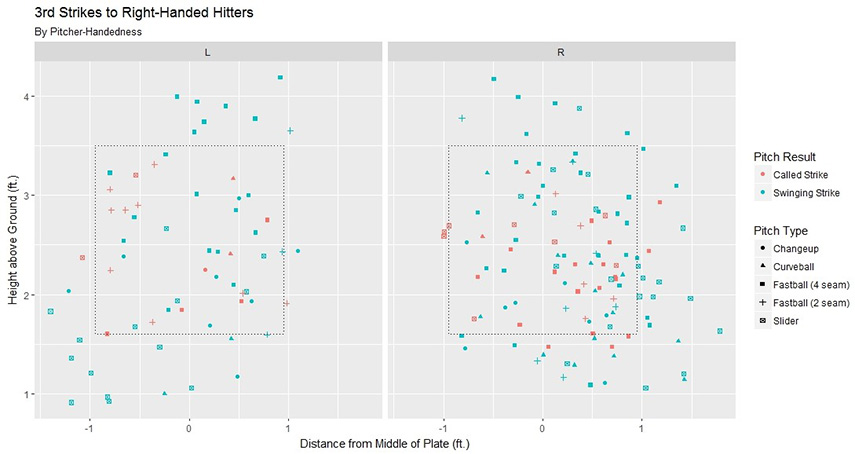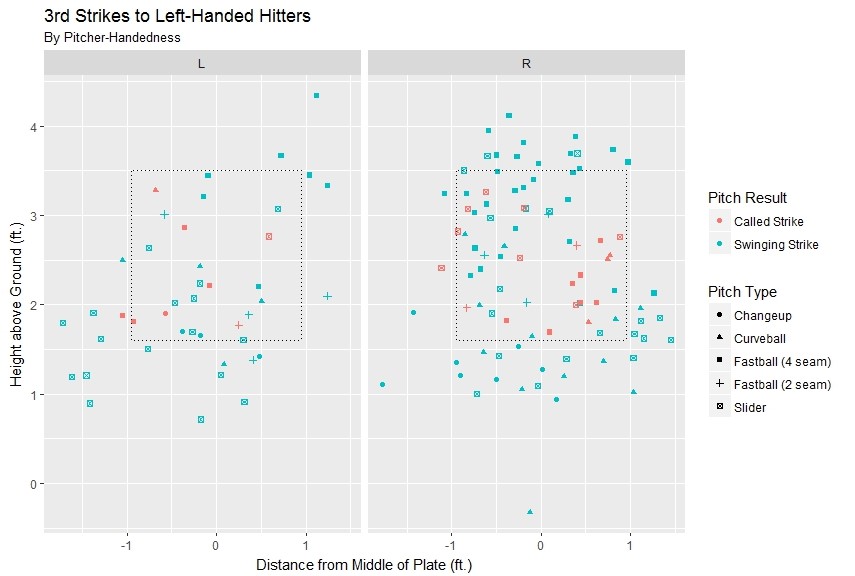Data analysis can enhance understanding of optimal coaching strategies. In this article, we will analyze pitches thrown for 3rd strikes to identify potential trends. We will use the information to propose optimal two-strike strategies for a fictional right-handed pitcher facing a left-handed hitter.
Assumption and Data Collection
Data was downloaded from MLB Advanced Media Gameday for two days of MLB games in July 2017. Note that this analysis can be conducted with data from other sources as well, whether it is gathered via data technologies or through a digital scorebook. Analysis from your own team/games is more likely to deliver specific, actionable insights for your team.
Only 4-seam Fastballs, 2-seam Fastballs, Sliders, Changeups, and Curveballs were kept in the data—to declutter the data and better identify trends in the most common pitches, Knuckleballs, Sinkers, and “Undefined” pitches were removed. The remaining data set includes 313 strikeouts available for analysis of the strike 3 pitch.
Identifying Trends
Identifying Trends
A visual of pitches thrown for strike 3 will help to identify trends. The graphs below are from the umpires view, and show the location and pitch type for strike 3 of the 313 strikeouts, as well as whether the result was a called strike or swinging strike.
There is a separate graph for right-handed hitters and left-handed hitters; each respective graph is then broken down by left-handed pitcher or right-handed pitcher.
First, we’ll look at the graphs for right-handed hitters. Strike 3 pitches from left-handed pitchers are on the left; right-handed pitcher results are on the right:

A quick observation of trends identifies the following:
- LHP get swinging strikes going down and in with sliders. There is also a small grouping of called 3rd strikes on the inner half from 2-seam fastballs.
- RHP have success going down and away with sliders or curveballs.
- LHP and RHP both go high-out-of-the-zone with 4-seam fastballs.
- RHP appear reluctant to attack the inner third of the plate, with almost no pitches off the plate inside.
Next, we’ll look at the graphs for left-handed hitters. Again, strike 3 pitches from left-handed pitchers are on the left; right-handed pitcher results are on the right:

Trends for left-handed hitter strikeouts include:
- LHP get swinging strikes going down and away with sliders.
- RHP go down and in with sliders and curveballs, or down and away with changeups, for swinging strikes.
- There is a grouping of called strikes from RHP in the bottom inner part of the zone.
- RHP have high-out-of-the-zone 4-seam fastballs for swinging strikes, similar to the trend seen against right-handed hitters.
Application
For a fictional right-handed pitcher facing a left-handed pitcher, we can use the above observations to identify a strategy for an “out” pitch:
- Does the pitcher have good “hop” on his fastball? If spin rate data is available, does the pitcher have a high spin rate? This might indicate that going high-out-of-the-zone with a 4-seam fastball could be an effective strategy.
- Does the pitcher have a plus slider or curveball? Going down and in may be the optimal strikeout pitch.
- Does the pitcher have a tailing fastball? Going down and in with such a fastball may generate the called strikes seen in the graph. Using the general trends, an individual strategy can be developed for each pitcher.
This is a cursory look at pitches thrown for strike 3. Opportunities to expand the analysis exist; for example, in examining the location and pitch type of the previous pitch, or evaluating strike 3 pitches by count (presumably, 0-2 swinging strikes would look different than those of a 3-2 count).